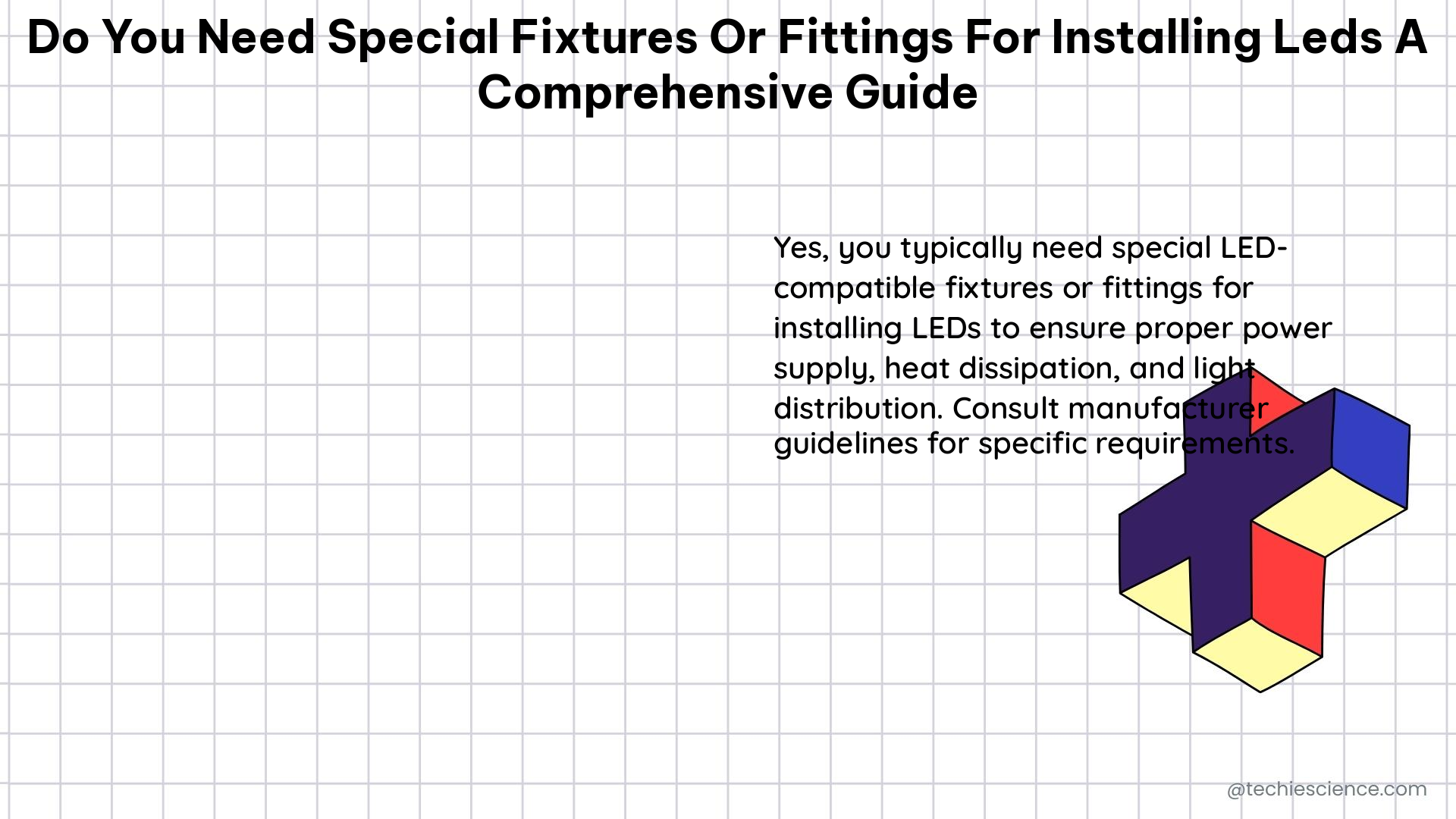When it comes to installing LED lights, the question of whether special fixtures or fittings are required is a common concern. This comprehensive guide will delve into the technical details and provide you with the necessary information to ensure a successful LED installation.
Understanding LED Power Consumption and Power Supply Requirements
One of the critical factors to consider when installing LEDs is the power consumption and the appropriate power supply selection. LED strip lights, for instance, have varying power requirements based on their length and type.
LED Strip Lights Power Consumption
Premium 24V COB (Chip-on-Board) LED strip lights typically consume 3.048 watts per foot. This means that a 16.4-foot COB light reel would require a 100-watt, 24V power supply, such as the EZDim unit, to ensure proper operation.
LED High Bay Lights Power Consumption
For LED high bay lights, the power consumption and recommended wattage vary based on the ceiling height. For a 20-foot ceiling, a 240-watt LED high bay light is generally recommended. However, it’s essential to consider the specific lighting requirements for your space to avoid blind spots or eye strain.
Selecting the Appropriate Fixtures and Fittings

The choice of fixtures and fittings for LED installation depends on the type of LED lights and the specific application.
LED Strip Light Fixtures and Fittings
When installing LED strip lights, you may need the following fixtures and fittings:
- LED Strip Light Channels: These are aluminum or plastic channels that provide a mounting surface for the LED strip and help with heat dissipation.
- End Caps: These are used to cover the exposed ends of the LED strip and provide a clean, finished look.
- Mounting Clips: These clips are used to securely attach the LED strip light channels to the desired surface, such as cabinets, under-counter areas, or coves.
- Connectors: Depending on the length of your LED strip, you may need to use connectors to join multiple strips together.
- Power Supplies: As mentioned earlier, you’ll need a compatible power supply that matches the voltage and wattage requirements of your LED strip.
LED High Bay Light Fixtures and Fittings
For LED high bay light installations, the following fixtures and fittings may be required:
- High Bay Light Fixture: This is the main housing that contains the LED light source and any necessary components, such as the driver and heat sink.
- Mounting Hardware: Depending on the specific high bay light fixture, you may need mounting hardware like chains, hooks, or brackets to securely install the fixture.
- Electrical Connections: Ensure that the high bay light fixture is compatible with the electrical wiring in your facility and that the connections are made properly and safely.
Compatibility and Dimmer Considerations
When installing LED lights, it’s crucial to ensure compatibility with the existing electrical system and any dimming controls.
Voltage Requirements and Dimmer Compatibility
LED lights often require a different type of dimmer compared to traditional incandescent or halogen bulbs. Be sure to check the compatibility of the dimmer with the LED lights you are using to avoid any issues with the dimming functionality.
Additionally, LED lights may have specific voltage requirements, such as 12V, 24V, or 120V. Ensure that the power supply and wiring are compatible with the voltage requirements of your LED lights.
Safety Considerations
Safety should always be a top priority when installing LED lights. Ensure that you follow all local electrical codes and guidelines, and consider the following safety measures:
- Proper Wiring and Grounding: Ensure that all electrical connections are made securely and that the system is properly grounded to prevent the risk of electric shock or fire.
- Heat Management: LED lights generate heat, so it’s essential to choose fixtures and fittings that provide adequate heat dissipation to prevent overheating and potential fire hazards.
- Moisture and Weatherproofing: If installing LED lights in damp or outdoor environments, use fixtures and fittings that are rated for the appropriate level of moisture and weatherproofing.
- Compliance with Regulations: Ensure that the LED lights and installation comply with any relevant building codes, safety standards, and energy efficiency regulations in your area.
Conclusion
In summary, the installation of LED lights may require special fixtures and fittings, depending on the specific application and the type of LED lights being used. By understanding the power consumption, voltage requirements, and compatibility considerations, as well as following proper safety protocols, you can ensure a successful and safe LED installation.
Remember to always consult with a qualified electrician or lighting professional if you have any doubts or concerns about the installation process.
Reference:
- Comprehensive Guide: How to Properly Install LED Strip Lights Under Counter and Cabinet
- A Guide to Installing High Bay LED Lights
- LED Lights Installation Guide for Beginners

The lambdageeks.com Core SME Team is a group of experienced subject matter experts from diverse scientific and technical fields including Physics, Chemistry, Technology,Electronics & Electrical Engineering, Automotive, Mechanical Engineering. Our team collaborates to create high-quality, well-researched articles on a wide range of science and technology topics for the lambdageeks.com website.
All Our Senior SME are having more than 7 Years of experience in the respective fields . They are either Working Industry Professionals or assocaited With different Universities. Refer Our Authors Page to get to know About our Core SMEs.